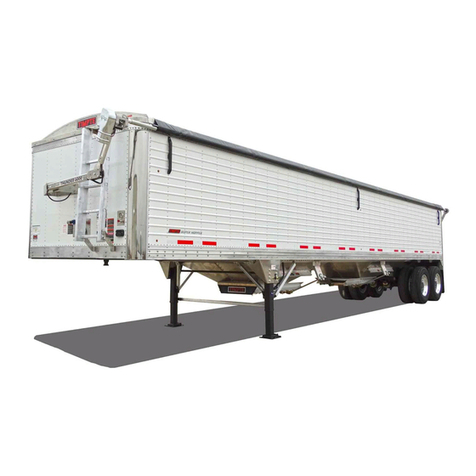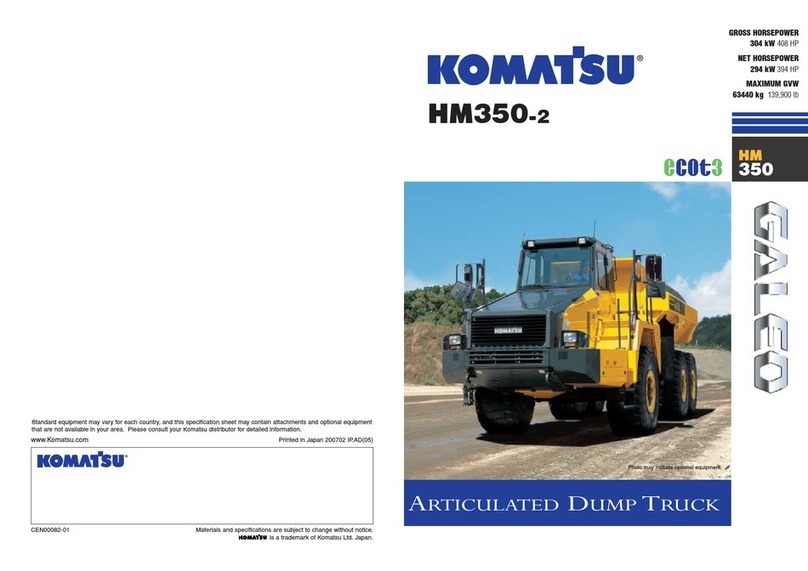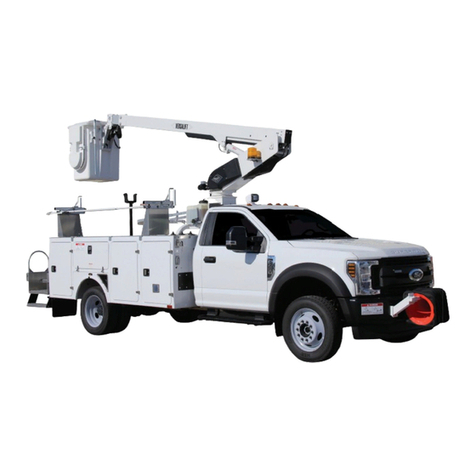Timpte 1420 STDO User manual

10
/
23
1420/1424
STDO Model

2
Timpte Equipment Trailers | User Manual
REPORTING SAFETY DEFECTS & OTHER CLAIMS
If you believe that this vehicle contains a safety defect you may contact Timpte, Inc., the Naonal
Highway Trac Safety Administraon (NHTSA) or both.
The trailer was designed and inspected to conform to industry standards and all applicable NHTSA
safety standards. Timpte, Inc. warrants this vehicle to be free from defects in materials and
workmanship when manufactured per the limited warranty agreement. If you detect a defect that
could cause an accident or could cause an injury or death; or if you wish to report any such accident,
injury or death, or any property damage claim or other complaint not addressed to the Timpte Trailer
Warranty Department, then you should contact in wring:
Timpte, Inc.
Vice President of Engineering
100 Timpte Parkway
David City, NE 68632
Phone: 402-367-3056
Fax: 402-367-4340
If you believe that your vehicle has a defect which could cause a crash or could cause injury or death,
you should immediately inform the Naonal Highway Trac Safety Administraon (NHTSA) in addion
to nofying Timpte, Inc.
If NHTSA receives similar complaints, it may open an invesgaon, and if it nds that a safety defect
exists in a group of vehicles, it may order a recall and remedy campaign. However, NHTSA cannot
become involved in individual problems between you, your dealer, or Timpte, Inc.
To contact NHTSA, you may call the Vehicle Safety Hotline toll-free at 1-888-327-4236 (TTY: 1-
800-424-9153); go to hp://nhtsa.safercar.gov; or write to: Administrator, NHTSA, 1200 New
Jersey Avenue SE, Washington, DC 20590. You can also obtain other informaon about motor
vehicle safety from hp://www.safercar.gov.
Timpte reserves the right to change or clarify the warranty coverage at any me. Contact the Timpte
Warranty Administraon Group at 402-367-3056 for any specic quesons on coverage.

IMPORTANT
This manual has been prepared to help you operate your new Timpte trailer successfully, economically,
and safely. Please read your Operator’s Manual carefully and have a full understanding prior to using
your trailer or performing any maintenance. We urge you to contact your Timpte, Inc. factory
representave or the Vice President of Engineering at Timpte (402-367-3056) immediately should you
have any quesons or need an explanaon.
Timpte has provided several warnings in your Operator’s Manual and on your trailer to help prevent
personal injury. Timpte can not foresee all use or misuse of the trailer. Always use common sense
judgment while using or performing maintenance to your trailer. Your safety is our primary concern.
This safety alert symbol is used throughout this manual to indicate potenal personal safety
hazards. Failure to heed the warnings associated with the safety alert symbol can result in
property damage, serious injury or death.
Safety decals appear at various locaons on your new equipment trailer. The decals are provided for
your safety and should be kept clean. Replace any decal that has become worn or damaged, painted
over, or otherwise dicult to read.
Informaon contained in this Operator’s Manual is based on the latest informaon available at the
me of publicaon. Changes are connually being made to improve our product lines.
We want to thank you for purchasing a Timpte trailer and to let you know that it was built for long life
and low cost of operaon. However, regular and proper maintenance of the trailer and your
commonsense use of it are required to extend the life of the trailer.
3
www.mpte.com

4
Timpte Equipment Trailers | User Manual
NORMAL TRAILER OPERATION
This Timpte trailer is designed for operaon within legal posted speed limits on reasonable road
surfaces for the type of service it was built to perform, in accordance with the noted weight
restricons.
“Normal Service” means the loading and transportaon of uniformly distributed loads of
properly secured, noncorrosive cargo, in accordance with any applicable factory instrucons and
in a manner which does not subject the trailer or parts of the trailer to (a) concentrated loads;
(b) loads in excess of the Gross Axle Weight Rang (GAWR) or Gross Vehicle Weight Rang
(GVWR) stated on the Cercaon Plate axed to the trailer by Timpte; and (c) accidental
damage, or (d) stresses, impacts or shocks greater than those commensurate with normal,
reasonable lawful use.
The GAWR (gross axle weight rang) is the structural capability of the lowest rated member of
the running gear components: suspension system, hubs, brake drums, wheels, bearings, axles,
brake linings or res.
The GVWR (gross vehicle weight rang) is the structural capability of the trailer when supported
by the coupler and axles with the load uniformly distributed throughout the cargo space.
Modicaon of the Trailer – Any modicaon made to the trailer must comply with DOT and
NHTSA regulaons and must not compromise the gross vehicle weight rang (GVWR) of the
trailer. Any modicaon made to the trailer without prior approval of Timpte may void the
warranty. Any operaon of the trailer outside the limitaons stated in this manual will void any
responsibility of Timpte, Inc. for any of its results.

SAFETY
WARNING
PERSONAL INJURY, DEATH, AND PROPERTY DAMAGE MAY RESULT FROM
IMPROPER OPERATION OR UNSAFE PRACTICES. BE SURE TO READ AND
FOLLOW ALL DECALS AND EMBLEMS CAREFULLY.
The following secon contains the decals and emblems used on the Timpte Equipment Trailers.
Due to dierences in conguraons and equipment, your trailer may or may not use all the
decals and emblems shown. Newer trailers may also have decals and emblems that dier from
older trailers. Replace damaged or missing decals promptly. Replacement decals for this trailer
are available without charge by calling Timpte, Inc. at 402-367-3056.
5
www.mpte.com
This manual suits for next models
1
Table of contents
Other Timpte Truck manuals


















